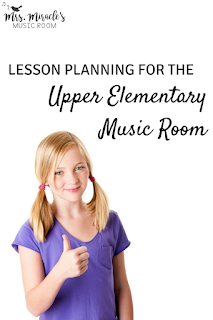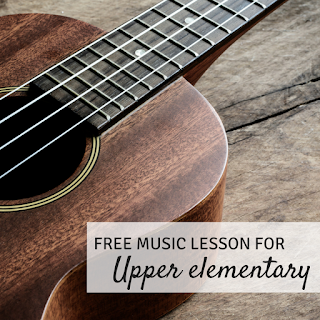Upper elementary can be a tough level to teach. They are sometimes "too cool" for school, and self-conscious of their singing voices. Academically they are advanced, yet musically they may need the basics. In this blog post, I'll detail my tips for lesson planning for the upper elementary music room. Keep reading for how to receive a free upper elementary music lesson with songs, materials, and more!
A little background about my situation: most of the fifth graders I teach, I've had since Kindergarten. I know, I'm very lucky! But I have been in other situations, where they needed a lot of help with the musical basics, where behavior was an issue, and where students didn't want to sing. Here are my suggestions for teaching and planning for upper elementary:
Choose songs and games wisely
When choosing song literature for fourth, fifth, and sixth grade, I am very careful. I make sure to choose songs that I know kids will love, yet can be used to teach concepts on which they are working.Here are some links to blog posts with songs and dances that upper elementary kids love:
Four White Horses (post by Beth from Beth's Music Notes)
Oboshinotentoten (found in this blog post)
'T Smidje (dance, blog post by David Row)
Pull concepts from songs
It's not uncommon to hear people talking about which songs work well for certain concepts, like which folk songs work well for teaching half note, or which work well for teaching low sol. I do often start with the concept and then brainstorm songs when I'm planning for lower elementary, but for upper elementary, I sometimes do the opposite. First, I come up with a list of songs that I think would work well for the upper elementary music classroom, then, I decide which concepts would work well for that song."Ye Toop Doram," found in this blog post, is a great example. I knew as soon as I learned it from my Level III teacher Joan Litman that my upper elementary students would love it...so I decided afterwards which concepts I could pull from it. It works well for low la and for syncopa. You could also use it for tam-ti, or dotted quarter/ eighth.
Give students a challenge
Students in fourth, fifth, or sixth grade may need some music foundational basics, but academically, they are ready for a challenge! Here are a few ways I've given students some challenges to keep them on their toes, while teaching them the basics:- Partwork rhythm: Take the rhythm to two songs and stack them on top of each other, in two different colors. Then have half of the class read the rhythm to one song while the other half of the class read the rhythm to the other!
- Cup game: The activity found in this blog post is really challenging, and great for building partwork skills!
- Beat in feet, rhythm in hands: This is also a great activity for building partwork skills! Have students walk around the room, keeping the beat, then put the rhythm in their hands as they sing a specific song. It's pretty tricky and will give them a challenge!
Make it relevant
As much as we have a curriculum to teach and have things in mind that we want to do with students, sometimes we have to sit back and listen to them. What do they want to do? Now, in some cases, you'd have kids tell you they want to listen to inappropriate rap songs, and of course you can't do that. But if you can pull something from what they tell you, or what you hear as you listen to them talk about music, then they will be that much more engaged."The Best Day of my Life" by the American Authors is a good example: kids at my school LOVE the song, and it's completely appropriate. I've tried this Orff arrangement for the song, I've had kids perform the song on a program, and I've used it to practice re (since the melody is d s m s m s m r d/ s m s m s m r d). In all three instances, kids were super excited. For the longest time in my teaching, I didn't touch pop music at all (as I detail in this blog post), but I realized that on top of students being more engaged, they were able to transfer their knowledge from folk song to pop song, which we definitely want them to be able to do!
Another way to make students relevant is to figure out which games they are playing on the playground and bring those into your music classroom. One night before a choir concert, I saw a bunch of my upper elementary students playing a game called Silent Ball, so I adapted the game for Sandy's Mill to include that; check out this post for the song and the Silent Ball game. By listening to them, you will give your students ownership of what they do in music class, which goes a long way!
Give students choices
Just like using relevant music and activities can give students ownership, so can giving students choices. Whether you simply ask students their opinions about something you're doing in your lesson, you have students compose, or you try any of the ideas in this blog post, choices create buy-in and engagement.Looking for more ideas for upper elementary lesson planning? Click on the picture below to receive a free upper elementary lesson plan, with songs, visuals, and more!
What are your lesson planning tips for upper elementary music? Feel free to comment below, and have fun!





Any thoughts on this:
ReplyDeleteI've taught my 6th graders for a couple of years. The group I've had all through are fairly advanced...they've learned pentatonic, extended, plus fa. Rhythm-wise they are to ti-tir-ri/tir-ri-ti; however, this year there are 4 new students who have never had any music classes where they are taught Kodaly, how to read on the staff and how to perform rhythms. How do I catch up these 4 while still challenging the rest of the class?